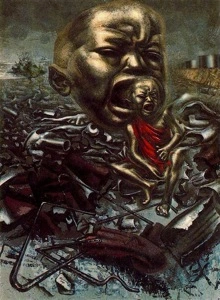I came across Echo of a Scream some months ago when my wife was taking a course in appreciation of art. She found it very interesting and hence showed it to me. First look at the painting and one will be puzzled at what really is this about – war? famine? disaster? So I started deciphering this painting one layer at a time.
Echo of a Scream is a haunting yet beautiful piece of art. A look at the painting evokes strong pathos – a tragedy always followed by a war. Throughout his career, David Alfaro Siqueiro created paintings depicting human struggle against authoritarian regime. He was born in the province of Chihuahua, Mexico in 1896. Enlisted in Venustiano Carranza’s Constitutional Army at the age of eighteen while studying art at the Academy of San Carlos. Siquero was a marxist from very early age. Much of his work had a direct influence from his first hand experience of the grief and suffering of war. His paintings also reflects his strong belief in Marxist ideology.

Echo of a Scream is Siqueiro’s iconic painting conceived in 1937 before he started working against Francisco Franco’s fascist dictatorship. The event which represents the painting is aftermath of a war and the trauma of human loss. Specifically the painting represents the famous Spanish civil war. The painting is captivating both visually and metaphorically. When we look at the painting the most prominent figure we see are two crying babies. One baby’s head is enlarged and other baby is coming out of his mouth. Baby is sitting on a surface which looks like a war zone. The ground shows the fallout of the war and the destruction that ensues. The visible elements are the shells, broken canons, and shrapnel.
The painting has a very rough and grungy texture. Siqueros used intense colors to represent a very dark and catastrophic period of time. On the top of the painting there are some dark clouds signifying the tough times caused by the war. On the left end corner of the painting we can see what looks like a tree on a barren land, accentuating the loss of the livelihoods of farmers. The debris on the land has rough edges and sharp corners, specifically the twisted metal in the frontal plane. The red color on the front of the painting near the twisted metal looks like human body parts and dried blood. The red cloth that baby is wearing symbolizes fresh blood still oozing out of his body. In a way it is a metaphor for the endless miseries of the war. Certain elements are placed in a very subtle manner in the painting such as the chimneys of the factories on the top right corner. It symbolizes the conflict between industrial growth and the traditional way of living. Why Siqueros chose African baby will always be open to interpretation. However considering the period when painting was composed as well as the fact that Spanish civil war used Morocco, an African country as treading ground might be a reason.
Echo of scream strikes its viewer in a very visceral manner. It immediately creates a very strong feeling of sorrow even without understanding the context. Siqueros succeeded in communicating with his audience. Although the painting is his point of view about the Spanish civil war but it is perfectly fitting even in the present world. It is a visually dark painting and intended to shake it’s viewer and forces them to think above their own selfish agendas and look out for the future generations. This painting creates a disturbing yet visually arresting picture.
When I saw the painting the very first emotion that went through my mind was an intense sorrow. The cry of little baby forced me to analyze the painting further and search for a reason of his grief and the source of all his pain and suffering. I forced myself to look for clues and visual cues which could possibly explain and answer all my questions. Looking deeply into the painting not as a passer but as an avid viewer opened more and more vantage points.
Echo of a scream is a multi-layered piece of art as most of the rich art forms are. For a casual onlooker its bleakness may be captivating but one needs to look a little closer and then it creates multitude of interpretations. The subject matter of the painting underscores the very fundamental theme that every war is different, yet every war is still the same. As Siqueros quoted “It is a call to all human beings so that they may end all wars”.
References and further reading
1. “Spanish Civil War”, http://en.wikipedia.org/wiki/Spanish_civil_war.
2. “David Alfaro Siqueiros”, http://en.wikipedia.org/wiki/David_Alfaro_Siqueiros.

